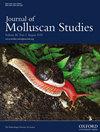墨西哥太平洋中部虎爪章鱼(头足纲:章鱼科)的营养生态学
IF 1.2
4区 生物学
Q2 MARINE & FRESHWATER BIOLOGY
引用次数: 1
摘要
墨西哥格雷罗州阿卡普尔科海岸的hubbsorum章鱼的饮食是通过分析2017年2月至2018年3月期间每月收集的413只章鱼的胃内容物来确定的。大多数胃(74.3%)有内容物,25.7%为空。60个猎物被确定并分为16类。最常见的猎物种类是三菲利佩石齿(Petrolisthes sanfelipensis)、裂齿石齿(Clastotoechus diffractus)、石齿石齿(Petrolisthes hians)和Alpheus spp. Smith’s index表明,在每个水文气候季节、性别和体型类别中,O. hubbsorum遵循着一种普遍的饮食习惯(1:幼鱼;2:青少年;3:成年)。同类相食在男性中很常见,而在女性中则不那么常见。皮亚卡指数显示,在旱季,两种性别的3个大小类重叠程度较高,而在雨季,两种性别的2和3个大小类重叠程度降低。平均同位素值δ13C - 14.96‰(±0.08),δ15N 13.02‰(±0.09)。不同水文气候季节(干、雨季)的δ13C差异显著(P = 0.005),不同水文气候季节的δ15N差异显著(P = 0.013)。胃内容物分析得出的hubbsorum的营养位置值为3.57 ~ 3.72,而稳定同位素分析(δ15N)得出的营养位置值为3.52 ~ 3.86。同位素生态位大小和外行人指标在水文气候季节之间存在差异。在旱季,2级和3级之间的同位素生态位重叠程度较高。岩石海岸生态系统已被手工渔业(鱼类和无脊椎动物)严重破坏。要对这些渔业进行更综合的、基于生态系统的管理,就需要了解它们的营养结构。本文章由计算机程序翻译,如有差异,请以英文原文为准。
Trophic ecology of the Hubb's octopus Octopus hubbsorum (Cephalopoda: Octopodidae) in the central Mexican Pacific
The diet of the Hubb's octopus Octopus hubbsorum along the coast of Acapulco, Guerrero, Mexico, was determined by analysing the stomach contents of 413 individuals collected monthly between February 2017 and March 2018. Most stomachs (74.3%) presented contents, while 25.7% were empty. Sixty prey items were identified and grouped into 16 categories. The most frequent prey items were Petrolisthes sanfelipensis, Clastotoechus diffractus, Petrolisthes hians and Alpheus spp. Smith's index indicated that O. hubbsorum follows a generalist diet for each hydroclimatic season, sex and size class (1: juvenile; 2: young adult; 3: mature adult). Cannibalism was frequent among males, less so among females. Pianka's index revealed a higher overlap among the three size classes of both sexes during the dry season, while during the rainy season the overlap was reduced for size classes 2 and 3 in both sexes. The average isotopic values overall were δ13C −14.96‰ (±0.08) and δ15N 13.02‰ (±0.09). A significant difference (P = 0.005) was observed in δ13C among hydroclimatic seasons (rainy and dry) and size classes, while for δ15N a significant difference (P = 0.013) was observed between seasons. Stomach content analysis gave values of the trophic position of O. hubbsorum ranging from 3.57 to 3.72, whereas the values obtained using stable isotope analysis, using δ15N, ranged from 3.52 to 3.86. Variation was observed in isotopic niche size and Layman's metrics among hydroclimatic seasons. A higher isotopic niche overlap was observed between size classes 2 and 3 during the dry season. The rocky shore ecosystem has been heavily exploited by artisanal fisheries (fish and invertebrates). A more integrated, ecosystem-based management of these fisheries requires an understanding of their trophic structure.
求助全文
通过发布文献求助,成功后即可免费获取论文全文。
去求助
来源期刊

Journal of Molluscan Studies
生物-动物学
CiteScore
3.00
自引率
8.30%
发文量
36
审稿时长
3 months
期刊介绍:
The Journal of Molluscan Studies accepts papers on all aspects of the study of molluscs. These include systematics, molecular genetics, palaeontology, ecology, evolution, and physiology. Where the topic is in a specialized field (e.g. parasitology, neurobiology, biochemistry, molecular biology), submissions will still be accepted as long as the mollusc is the principal focus of the study, and not incidental or simply a convenient experimental animal. Papers with a focus on fisheries biology, aquaculture, and control of molluscan pests will be accepted only if they include significant advances in molluscan biology. While systematic papers are encouraged, descriptions of single new taxa will only be considered if they include some ‘added value’, for example in the form of new information on anatomy or distribution, or if they are presented in the context of a systematic revision or phylogenetic analysis of the group.
 求助内容:
求助内容: 应助结果提醒方式:
应助结果提醒方式:


